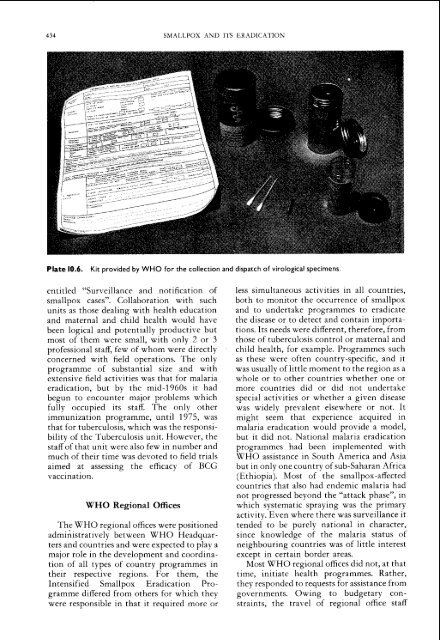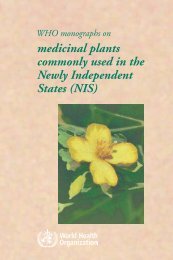smallpox eradication - libdoc.who.int - World Health Organization
smallpox eradication - libdoc.who.int - World Health Organization
smallpox eradication - libdoc.who.int - World Health Organization
Create successful ePaper yourself
Turn your PDF publications into a flip-book with our unique Google optimized e-Paper software.
434 SMAI.LPOX AND 1I'S EKADICA'I'ION<br />
Plate 10.6.<br />
Kit provided by WHO for the collection and dispatch of virological specimens<br />
entitled "Surveillance and notification of<br />
<strong>smallpox</strong> cases". Collaboration with such<br />
units as those dealing with health education<br />
and maternal and child health would have<br />
been logical and potentially productive but<br />
most of them were small, with only 2 or 3<br />
professional staff, few of <strong>who</strong>m were directly<br />
concerned with field o~erations. The onlv<br />
programme of substankal size and with<br />
extensive field activities was that for malaria<br />
<strong>eradication</strong>, but by the mid-1960s it had<br />
begun to encounter major problems which<br />
fully occupied its staff. The only other<br />
immunization programme, until 1975, was<br />
that for tuberculosis, which was the responsibility<br />
of the Tuberculosis unit. However, the<br />
staffbf that unit were also few in number and<br />
much of their time was devoted to field trials<br />
aimed at assessing the efficacy of BCG<br />
vaccination.<br />
WHO Regional Offices<br />
The WHO regional offices were positioned<br />
admiAistratively between WHO Headquarters<br />
and countries and were expected to play a<br />
major role in the development and coordination<br />
of all types of country programmes in<br />
their respective regions. For them, the<br />
Intensified Smallpox Eradication Programme<br />
differed from others for which they<br />
were responsible in that it required more or<br />
less simultaneous activities in all countries,<br />
both to monitor the occurrence of <strong>smallpox</strong><br />
and to undertake programmes to eradicate<br />
the disease or to deiectand contain im~ortations.<br />
Its needs were different, therefore, from<br />
those of tuberculosis control or maternal and<br />
child health, for example. Programmes such<br />
as these were often country-specific, and it<br />
was usually of little moment to the region as a<br />
<strong>who</strong>le or to other countries whether one or<br />
more countries did or did not undertake<br />
special activities or whether a given disease<br />
was widelv ~revalent elsewhere or not. It<br />
, L<br />
might seem that experience acquired in<br />
malaria <strong>eradication</strong> would provide a model,<br />
but it did not. National malaria <strong>eradication</strong><br />
programmes had been implemented with<br />
WHO assistance in South America and Asia<br />
but in only one country of sub-Saharan Africa<br />
(Ethiopia). Most of the <strong>smallpox</strong>-affected<br />
countries that also had endemic malaria had<br />
not progressed beyond the "attack phase", in<br />
which systematic spraying was the primary<br />
activity. Even where there was surveillance it<br />
tended to be purely national in character,<br />
since knowledhe of the malaria status of<br />
D<br />
neighbouring countries was of little <strong>int</strong>erest<br />
except in certain border areas.<br />
Most WHO regional offices did not, at that<br />
time, initiate health programmes. Rather,<br />
they responded to requests for assistance from<br />
governments. Owing to budgetary constra<strong>int</strong>s,<br />
the travel of regional office staff
















